While Location Based Services seem to be regarded as the "Next New Thing," it is unclear that LBS will result in "profit" for the majority of the players involved, although it is likely that there will be significant revenues generated by the industry.Let us look at the industry by observing trends in the market and, then, consider the segmentation of the market in order to try to understand the players that might profit as opposed to those who will not profit.
I define LBS as wireless communication technology that combines network services and positioning technology to provide a subscriber with position related services.The service may be available from a mobile handset or other communications device.
Industry Market Overview
Negative Trends
In today's wireless marketplace, voice services are considered a "commodity
business" that do not provide carriers a chance to differentiate themselves.
Next, the rollout of 2G data services has been unsuccessful from a profit
perspective.Finally, there are limited technology standards in the US
market and this situation provokes difficult and costly issues for the
developer community..
Positive Trends
The next generation "always on" networks will provide sophisticated
Location Based Services and faster access speeds.Enhanced devices with
more capable and intuitive user interfaces will become common.Cross carrier,
"push-based" messaging and alerts will be available in the US (Alert services
are available today but not reliably and not cross-carrier).
Future Issues
Carriers are looking to create "stickiness" as a method of monetizing
their wireless infrastructure. Although voice is currently 90% of
wireless carriers' income, it has been forecast that data and other non-voice
services will generate 50% of wireless carrier income by 2005. It
is clear that carriers would like LBS to be an enabler for monetizing their
wireless infrastructure. However, the push towards 3G services is
moving forward with limited standardization. Ninety percent of the
3G licenses awarded will use some form of WCDMA as core technology while
during the 20003-2005 timeframe, TDMA/GSM/WCDMA terminals will account
of over 60% of the global market place.
Changing Technology
One of the major obstacles to successfully monetizing the wireless
infrastructure is that those desiring to provide data services and other
non-voice services must support myriad technology.
It is clear that there will be significant change in wireless network
technology over the next three to five years.
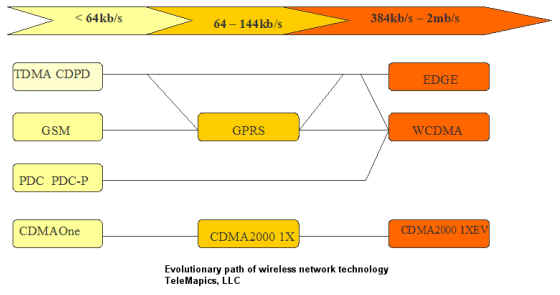 The issue of wireless networking technology converts to the following carrier
adoptions:
The issue of wireless networking technology converts to the following carrier
adoptions:
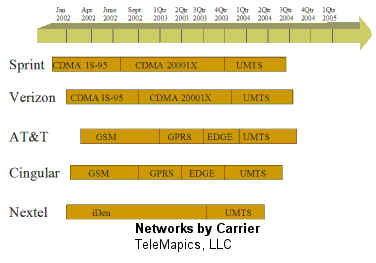 Next, LBS depends on ALI implementation:
Next, LBS depends on ALI implementation:
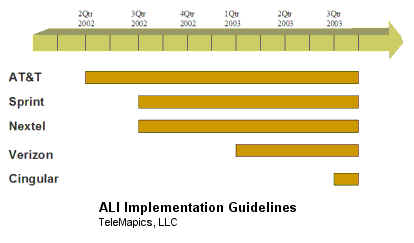 Developing LBS, also, will depend on supporting various micro-browsers:
Developing LBS, also, will depend on supporting various micro-browsers:
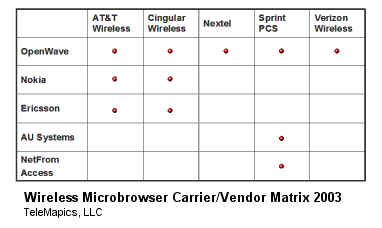 Next, LBS implementations will be influenced by development platforms and
Gateways:
Next, LBS implementations will be influenced by development platforms and
Gateways:
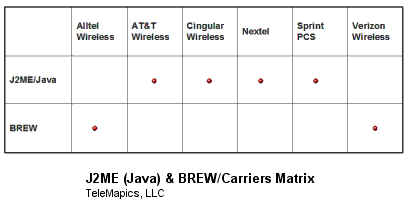
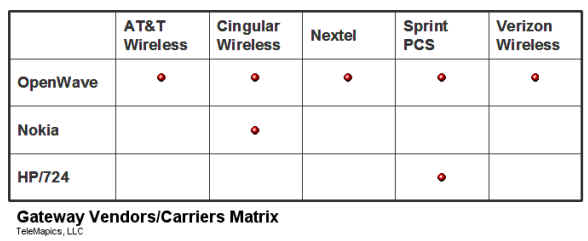 Additionally, it is somewhat disconcerting to consider that supplier must
consider the diversity of individual phones and complications
related to the fact that application bug fixes are often device specific
(client side) and may need to be applied at the phone level (raising
the need to support server side and device resident applications).
Additionally, it is somewhat disconcerting to consider that supplier must
consider the diversity of individual phones and complications
related to the fact that application bug fixes are often device specific
(client side) and may need to be applied at the phone level (raising
the need to support server side and device resident applications).
It is clear that the diversity of technology comprising the wireless infrastructure supporting the carriers' platforms provokes the need for those working in LBS to develop and support a complex, service provider environment. These development and support expenses are continuing obligations that spiral as your application supports more carriers. Unfortunately, having more customers does not guarantee that you have more income as development and support costs may exceed the compensation offered by the carrier. While this sounds counter intuitive, you should consider that most carriers operate a "walled garden" Internet and unless you are inside of their walls, you do not receive any visitors. Finally, it is important to note that carriers, today, are attempting to provide increasingly services based on proprietary offerings. Providers with unique services are being pushed to the periphery of the Wireless Web.
How Will the Game Play Out?
It is clear that the carriers will generate substantial revenue from
LBS services due to their role as infrastructure providers (and gatekeepers).
Whether or not the carriers will generate profit is unclear due to the
financial issues relating to the acquisition of spectrum and providing
a reliable infrastructure that must operate under significant government
oversight and regulation.
Who else will make money in LBS, and of those, will anyone make a profit?
Based on our familiarity with LBS, Wireless and Technology, TeleMapics
offers the following chart, presenting our best estimates of where the
"money will flow in LBS":
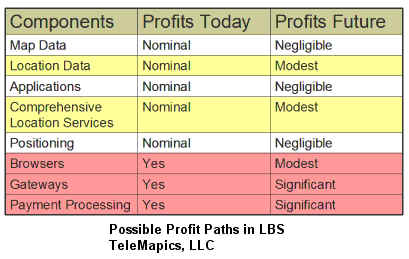 It is TeleMapics position that the "take off" of LBS services will be slow
and complicated by the fact that Carriers are not presently prepared to
sell LBS (ask a carrier's sales representative to explain how to use the
wireless Internet to gain some understanding of the scope of this problem).
Next, although it was believed that applications involving safety would
lead the market, there has been some reconsideration of this assumption
based on the poor renewal rate for GM's OnStar service (which has been
characterized by consumers as a safety based service).Also, the assumption
that LBS "push-based" services would be attractive to consumers has been
reconsidered as a "marketing idea gone bad". Further, today's LBS
applications are "clumsy" and location data (not map data) are so poor
in quality that LBS is dismissed by consumers as ineffective. Although
early adopters and "True Believers" love LBS, the size of these groups
does not constitute a mass market capable of generating sustainable, profit-based
growth.
It is TeleMapics position that the "take off" of LBS services will be slow
and complicated by the fact that Carriers are not presently prepared to
sell LBS (ask a carrier's sales representative to explain how to use the
wireless Internet to gain some understanding of the scope of this problem).
Next, although it was believed that applications involving safety would
lead the market, there has been some reconsideration of this assumption
based on the poor renewal rate for GM's OnStar service (which has been
characterized by consumers as a safety based service).Also, the assumption
that LBS "push-based" services would be attractive to consumers has been
reconsidered as a "marketing idea gone bad". Further, today's LBS
applications are "clumsy" and location data (not map data) are so poor
in quality that LBS is dismissed by consumers as ineffective. Although
early adopters and "True Believers" love LBS, the size of these groups
does not constitute a mass market capable of generating sustainable, profit-based
growth.
Finally, LBS services will suffer from confidentiality issues and this concern will further impede the market. The success of the industry requires that customers believe confidentiality is not a problem. Today, the majority of consumers are uneasy about possible extension of LBS to "surveillance databases"
What Might Change the Outlook for Profitability in LBS?
- Profitability in the market for LBS could change in an instant, if existing Yellow Page Companies were to embrace LBS. These companies have successful franchises that include location information. They, also, have viable sales channels. Unfortunately, most of the existing Yellow Page companies are wary of the Wireless Internet, as it is considered a distraction from today's exceptionally robust revenue stream.
- Today's LBS solutions amplify the center and leave the periphery unacknowledged. Adding location information surrounding a person's position is similar to providing peripheral vision to a person who has been limited to seeing with tunnel vision. At TeleMapics, we feel that the possibility of creating "knowledge ecologies" may make LBS a desired application, particularly if a method is developed to transfer to LBS the information contained in "Community Based Knowing".
- Finally, it is possible that the simultaneous voice and data capabilities of 3G networks will allow voice interrogation to be coupled with visual inspection of "pick lists, solving the difficult problem of searching for location targets presented on phone based systems.
In order to create a profitable LBS industry, the players need to develop an inviting and invisible technology. There is a need to create LBS that help make sense of the surrounding world when our customers require this type of help.
(This paper was based on a presentation delivered at a Special Session
of the World Congress on Intelligent Transportation Systems in October
2002. Michael L.Sena of Michael L.Sena Consulting AB [ml.sena@mlscab.se]
graciously arranged the Special Session)